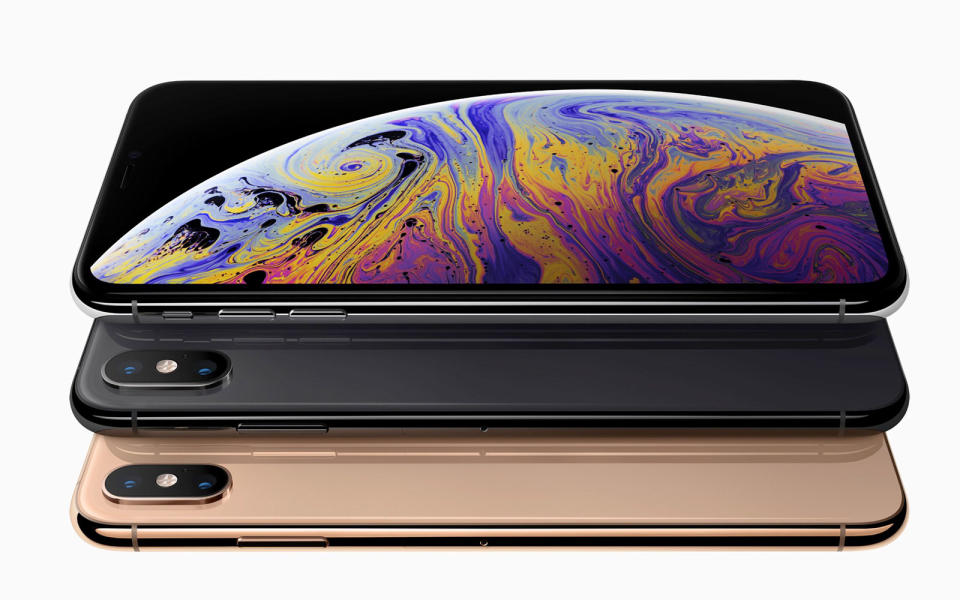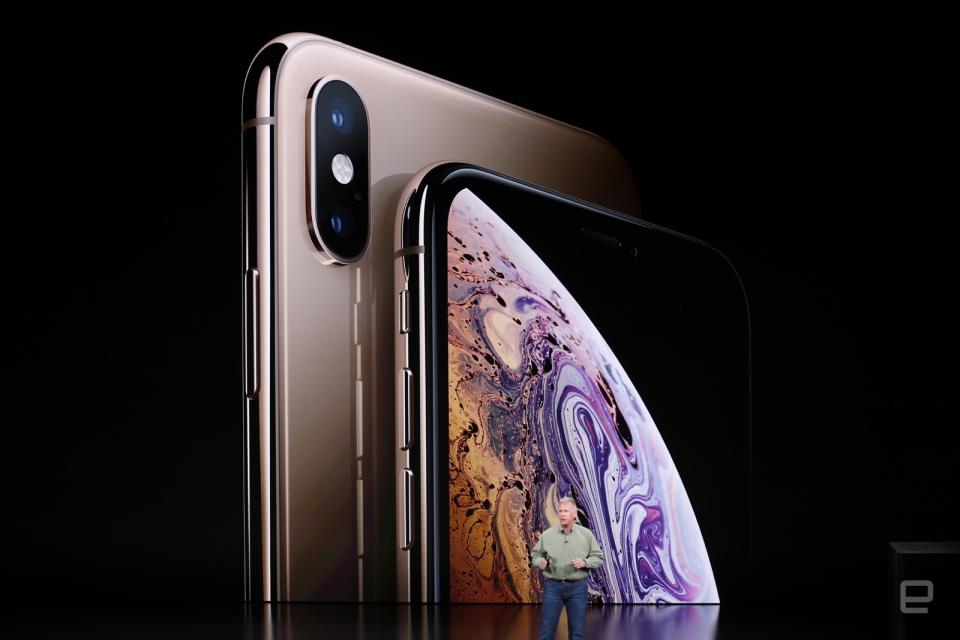Apple’s iPhone Xs and Xs Max are all about the display
For those that need the biggest screen possible, Apple has you covered.
If you've been following the Apple rumors lately, the big news from today's event should come as no surprise. The new flagship iPhone Xs and Xs Max have just been announced, and so far they match up with everything that was rumored. The iPhone Xs sticks with the same notched, 5.8-inch OLED display found on last year's model, which the Xs Max steps up to a massive 6.5-inch panel. That panel also features what Phil Schiller says is the strongest smartphone glass ever made. CEO Tim Cook calls it "the most advanced iPhone we've ever created" -- no surprise there. Beyond the iPhone Xs Max's huge screen and a brand-new gold color (which looks unsurprisingly similar to the new Apple Watch Series 4), these phones are visually pretty similar to last year's iPhone X. That means a stainless steel band, a glass back, the large dual-camera hump and -- of course -- no headphone jack. You can't see it, but the iPhone Xs and Xs Max are more water- and dust-resistant than before. The iPhone Xs and Xs Max are also the first iPhones that'll support dual SIM, with a physical SIM card and Apple's own eSIM. For China, Apple is specifically making a phone with two physical SIM slots for the first time. The major hardware advances start with the display. Naturally, the 6.5-inch iPhone Max has a resolution of 2,688 x 1,242 with the same pixel density of the iPhone Xs. They both have HDR, Dolby Vision and HDR 10. There's also a 120Hz touch-sensing rate, which Apple said helps the phone detect your touches faster. And Face ID is getting a speed boost as well: Apple didn't give specifics, but few will complain about unlocking their phone more quickly. The new processor inside these phones is the A12 Bionic, and it's the first iPhone chip made with the 7-nanometer chip. Schiller reviewed three notable components. The CPU has six cores, with two performance cores and four efficiency cores, but they run with 40 and 50 percent improved efficiency, respectively. The four-core GPU is up to 50 percent faster, and the neural engine is significantly faster than the model in last year's chip. It can run 5 trillion operations per second, up from 600 billion in last year's A11 chip. Long story short, this should be a very fast phone. That neural network chip is what powers Apple's on-device machine learning, which is becoming an increasingly important part of Apple's devices. Indeed, Apple spent time digging into just how the machine learning chip enhances the capabilities of the iPhone. Some of the main benefits are camera-related, for things like Animoji and portrait modes. But it's also important for AR, which is another key feature for Apple's iOS devices going forward. Additionally, the neural processor takes some pressure off the GPU, which means it can spend more of its power on rendering graphics and real-time lighting. It took Apple a while to get to it, but both the front- and rear-facing cameras got upgraded as well. Like last year, the wide-angle and telephoto cameras are both 12 megapixels, but there's a new sensor for the wide-angle camera. Both cameras have optical image stabilization as well, and the True Tone sensor has also been improved. The front-facing camera sticks with a 7-megapixel camera, but it also has a faster sensor than last year's. In keeping with the theme of Apple's powerful processor, Schiller spent plenty of time talking about how the processor helps make better images and said that every time you take a picture the A12 carries out 1 trillion operations. And all this power is being used for a new feature called Smart HDR. To put it simply, the camera takes many photos in one shot to merge them all together so everything is properly exposed. That's the basic concept of HDR, but we didn't get a lot of detail on exactly how this differs from past implementations. It sounds like the processor's power allows for more shots to be taken and the phone is smarter about merging them all together. Additionally, portrait-mode results look better than before: The software-created background bokeh (the out-of-focus background that makes portraits pop) is more sensitive than before. Apple is also including a slider that lets you adjust the depth of field on a portrait photo even after the image has been shot. So if you want the background to be a bit more in focus than in the original shot, you can use that slider to get it just how you like. On the video side, Apple has finally added stereo sound recording. iPhone videographers, rejoice. There aren't huge changes to battery capacity this year. Apple said that the Xs gets about 30 minutes more battery than the iPhone X while the Xs Max has the biggest iPhone battery ever and gets an hour and a half more use time. If you're someone who's really hard on your battery, the Xs Max is probably the iPhone for you. Prior to today's announcement, there was plenty of info out there pointing to the iPhone XS and XS Max. Just this morning, Allthings.how found evidence on Apple's own site that all but confirmed the phones' naming scheme, color options and storage sizes, which include the first 512GB iPhone. Finally, the big question: price. The iPhone Xs starts at $999 for the 64GB model while the Xs Max starts at a mind-blowing $1,099. Pre-orders for the Xs and Xs Max start on September 14th, and they'll ship on September 21st. And if you're wondering how much a fully spec'd 512GB iPhone Xs Max costs? Well, that'll set you back an eye-popping $1,449. That's more than many of Apple's full-featured computers. Scrounge up that couch change, indeed. Follow all the latest news from Apple's 2018 iPhone event here!






















